Nazi-Era Provenance
From the time it came into power in Germany in 1933 until the end of World War II in 1945, the Nazi regime instituted a program of theft, confiscation, coercive transfer, looting, and destruction of objects of art and other cultural property in Europe on an unprecedented scale. During the post-war occupation of Germany, thousands of works of art were repatriated to their countries of origin or their rightful owners. In recent years, American museums have been actively engaged in the identification and restitution of looted art in cooperation with the American Association of Museums (AAM).
In conjunction with the AAM's Nazi-Era Provenance Internet Portal, the Flint Institute of Arts is providing a list of works of art from the permanent collection that qualify as "covered objects," (please consult the description of covered objects in the text below). Below is a current list of detailed records of works of art with images, which can be explored further by clicking on the thumbnail. Additional records will be added as research progresses through the museum's permanent holdings.
Research
In the past decade, U.S. museums have come to recognize that objects unlawfully appropriated during the Nazi era without subsequent restitution— that is with neither return of the object nor payment of compensation to the object's original owner or legal successor—may have made their way into U.S. museum collections in the decades since the war. In 1998, the American Association of Museum Directors, after years of work, ratified a document which clearly outlined the principles and guidelines for dealing with related issues, and issued a mandate for museums to conduct research, post findings, and resolve provenance issues before new works are acquired.
The Flint Institute of Arts has conducted research on its collection, using the principles and guidelines established by the American Association of Museums (AAM) to determine if works of art in the collection may have been illegally confiscated by the Nazis in the 1930s and 1940s.
The ultimate goal of the project is to publicly post objects which have questionable ownership histories on the AAM's Nazi-Era Provenance Internet Portal (www.nepip.org) to assist people seeking objects lost or misappropriated in continental Europe during the Nazi era (1933-1945). The FIA is undertaking this project now, while some Holocaust survivors are still living. Members of the public can use the Portal's database of objects in U.S. museum collections to refine their searches.
This specialized research into the history of an artwork's ownership (provenance) is an important means of establishing legal ownership of the work. The FIA has made provenance research a top priority, as mandated by the AAM. The research project and the public dissemination of its findings will be conducted in accordance with the guidelines adopted by the AAM in June 1998. This dissemination of information through the AAM's Portal will not only aid in the identification of Nazi stolen works of art and their subsequent repatriation, but will also serve to broaden the public's awareness of this important issue. Through this project, the FIA will be able to fulfill its responsibility to make information about objects in its collection centrally accessible to the public.
Researching the history of an artwork's ownership and providing provenance information to the public is consonant with the fundamental mission of museums to document and publish their collections. By participating in the AAM's Nazi-Era Provenance Internet Portal through listing any works in the collection of the FIA which have histories that may be linked to continental Europe during the period of the Nazi regime, the Flint Institute of Arts is demonstrating its commitment to the open and responsible stewardship of the objects under its care. Adherence to the guidelines set out by AAM regarding the identification of potential Nazi stolen art and its appropriate restitution is paramount to the success of this project. The Flint Institute of Arts believes that performing research on its collection for this project will result in not only achieving the goals set out by the use of the Portal, but will also serve to promote the highest standards of accountability and ethical practices in the museum field.
The Flint Institute of Arts' Nazi-Era Provenance Research Project will focus its research on approximately 500 objects in the permanent collection which fall under the categories identified by AAM, in order to determine whether or not they are considered "covered objects" those with questions in their ownership histories sufficient enough to be listed on the Internet Portal. "Covered objects" include artworks: 1) that were created before 1946 and acquired by the museum after 1932; 2) that underwent a change in ownership between 1932 and 1946; 3) and that were, or might reasonably be thought to have been, in continental Europe between 1932 and 1946.
The AAM has also identified styles of art most collected by the Nazis, as well as "red-flag" names in provenance documents which have been identified by government resources as having relation to Nazi stolen objects. Following these guidelines, the Flint Institute of Arts will begin its Nazi-era research with European paintings. Research of the permanent collection will also extend to decorative arts, sculpture, tapestries, and works on paper. The goal of the FIA's research is to eventually post all of the "covered objects" in the museum's permanent collection on the AAM's Nazi-Era Provenance Internet Portal and the FIA's host web site. A number of different sources will be used in conducting the research, including curatorial files, museum and gallery archives, and governmental agencies.
| Objects | |||
|---|---|---|---|
 | Anonymous Figural Landscape with Ruins |  | Anonymous Figural Landscape with Ruins |
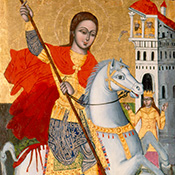 | Anonymous Saint George and the Dragon | 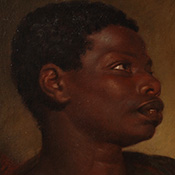 | Jean-Baptiste-Jacques Augustin (attributed to) Study of a Black Youth |
 | Eugéne-Louis Boudin Trouville, L'Avant Port | 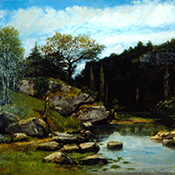 | Gustave Courbet Le Ruisseau de Plaisir-Fontaine |
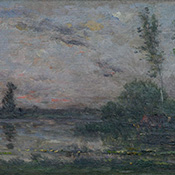 | Charles-François Daubigny Landscape with Figure and Two Cows |  | Charles-François Daubigny Paysage avec Personnnages au Printemps, La Bonneville |
 | Edouard-Joseph Goerg L'Innocence | 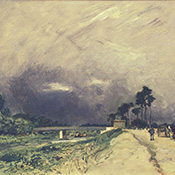 | Johan Barthold Jongkind Route le Long d'une Riviére |
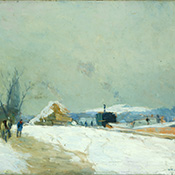 | Albert Lebourg Effet de Neige aux Portes de Paris |  | Robert Lotiron Café Near River |
 | Albert Marquet Poissy, la barque verte | 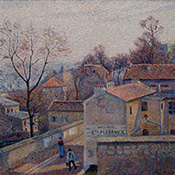 | Lucien Pissarro La Rue Saint-Vincent, Soleil d'Hiver |
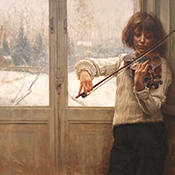 | Salvatore Postiglione Boy with Violin |  | Pierre-Auguste Renoir Coco |
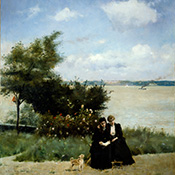 | Alfred Stevens Terrace at Honfleur | 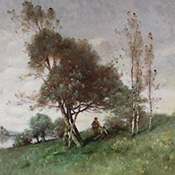 | Paul Désiré Trouillebert On the Seine, Normandy |
 | Maurice Utrillo Le Lapin Agile |  | Jan van Kessel Air |
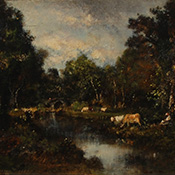 | Paul Vernon Landscape with Cow |


